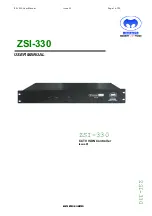
RAM Control Module
432
SPRUH22I – April 2012 – Revised November 2019
Copyright © 2012–2019, Texas Instruments Incorporated
Internal Memory
Table 5-2. Error Handling in Different Scenarios
Access Type
Error Found In
Error Type
Status Indication
Error Notification
M3/uDMA Byte Write (R-
M-W)
Data read from memory
Uncorrectable Error
(Parity Error OR Double
bit ECC Error)
M3/uDMA Write Address
Error Register – Indicates
address for which error
happened
NVIC Interrupt for uDMA
access / bus fault for M3
access
M3/uDMA Byte Write (R-
M-W)
Data read from memory
Correctable Error
No
None
Reads
Data read from memory
Uncorrectable Error
(Parity Error OR Double
bit ECC Error)
Yes - M3 / uDMA / C28
CPU / C28 DMA Read
Address Error Register
Data returned to M3 CPU
/ uDMA or C28 CPU / C28
DMA is incorrect
NMI for C28 CPU access
NMI for C28 DMA access
BUS FAULT for M3 CPU
access
Interrupt for uDMA access
Reads
Data read from memory
Single data error
Yes - M3 / uDMA / C28
CPU / C28 DMA Read
Address Error Register
Increment single error
counter
Interrupt on error counter
reaching the user
programmable threshold
for single errors
Reads
Address
Address error
Yes - M3 / uDMA / C28
CPU / C28 DMA Read
Address Error Register
Data returned to M3 CPU
/ uDMA or C28 CPU / C28
DMA is incorrect
NMI for C28 CPU access
NMI for C28 DMA access
BUS FAULT for M3 CPU
access
Interrupt for uDMA access
Notes:
In case of uncorrectable error duing fetch on C28x CPU, there is possibility of getting ITRAP
before NMI, since garbage instructions enters into C28x pipeline before NMI gets generated.
During debug accesses (RD/WR) correctable as well as uncorrectable errors are masked.
5.1.1.8
Application Test Hooks for Error Detection and Correction
Since error detection and correction logic is part of safety critical logic, safety applications may need to
ensure that the logic is working fine always (during run time also). To enable this, a RAMTEST mode is
provided. When “RAMTEST” mode is set (ECCPARTEST=1), the ECC/parity logic gets bypassed. For
example, while writing the data, only data bit’s will be written into memoy not the ECC/parity bits for data
and address. Using this feature an ECC/parity error could be injected into data. Also, the ECC/parity bits
for each address location are memory mapped in separate memory locations, accessible directly by the
CPU. The memory mapped ECC or parity bits can also be changed by the software. During read back, the
ECC / parity logic will detect an error thereby confirming to the application code that ECC/parity logic
works fine. If not then application should consider this as an error condition and handle it accordingly.
Notes:
The memory map for ECC/parity bits is accessible only when the RAMTEST mode is selected
(ECCPARTEST=1) or else reads to these address locations return ‘0.’
In RAMTEST mode, all access to memories (data as well as ECC/partiy) should be done as 32-bit access
only.
The following table shows the bit mapping for the ECC/parity bits when they are read in RAMTEST mode
using their respective addresses.















































